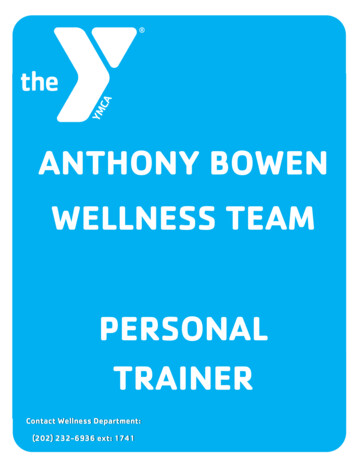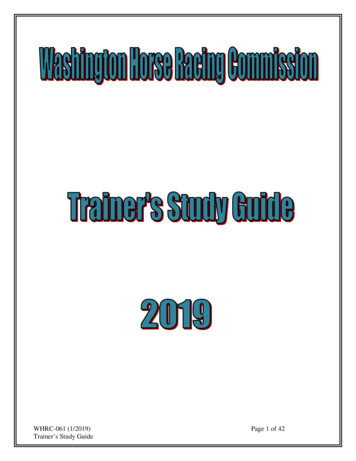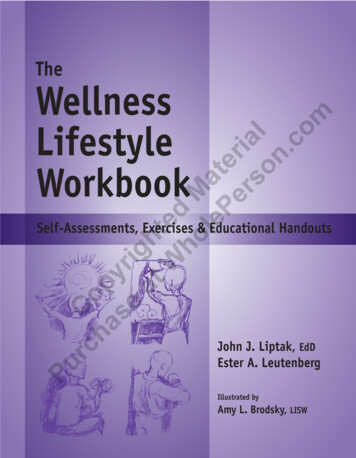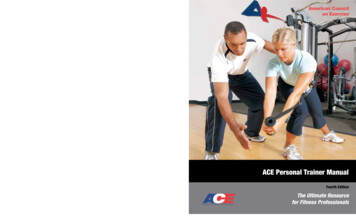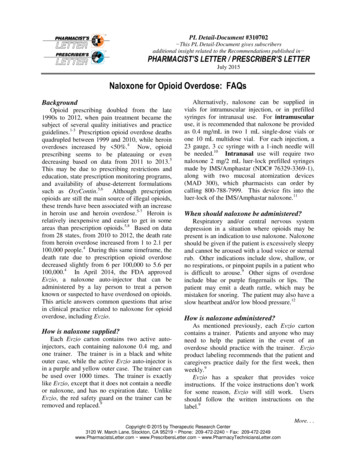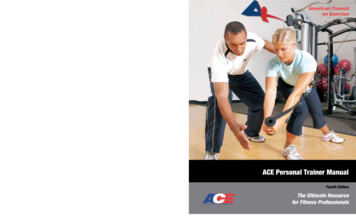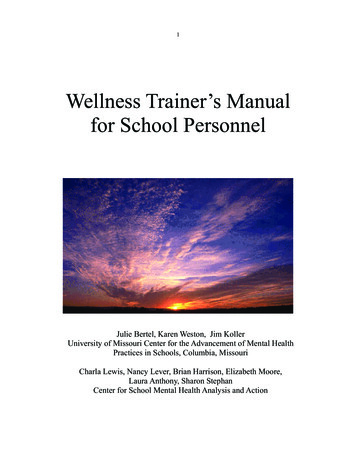
Transcription
1Wellness Trainer’s Manualfor School PersonnelJulie Bertel, Karen Weston, Jim KollerUniversity of Missouri Center for the Advancement of Mental HealthPractices in Schools, Columbia, MissouriCharla Lewis, Nancy Lever, Brian Harrison, Elizabeth Moore,Laura Anthony, Sharon StephanCenter for School Mental Health Analysis and Action
2We encourage the use of this manual in its entirety for the purpose ofconducting support group for staff within the school setting. Borrowedcontent from the manual must be cited appropriately, protecting theacademic/intellectual property of the developers. All rights are reservedby the authors. Permission has been granted only for the copying and useof this manual for wellness efforts for school hired and school-based personnel. Permission for copying and use of the manual for any otherpurpose is not granted. Special permission would need to be obtainedfrom the authors for the use of the manual in any other capacity. We arehopeful that this manual will help structure wellness groups in schools. Asthis is the first edition of the manual, we would like to solicit feedback andsuggestions for improvement and modification. This manual representsongoing collaborative efforts between the Center for School MentalHealth Analysis and Action and the University of Missouri Center for theAdvancement of Mental Health Practices in Schools. The content of thismanual has greatly benefited from the research, teaching, and practiceexperiences of both Centers. Please send your feedback andrecommendations to nlever@psych.umaryland.edu and/orKollerJ@missouri.eduDate of Publication: October 2005
3Session 1 – Introduction to Wellness GroupObjectives: To review the purpose of the group and the value ofwellness to overall health and job performance.To introduce and discuss the concept of occupational stress andunique stressors related to school-based workTo assess and become more aware of personal stressorsResources:Pullis Stress InventoryScoring for Pullis InventoryPurpose of GroupThe purpose of this group is to provide an opportunity for promoting wellness inschool-based staff. Many school-based professionals are so busy taking care ofeveryone else that they neglect their own wellness. Investing time and energy intothe wellness of the caregiver is often overlooked. With the many academic, social,and emotional needs of children today, at times working in the school can feel overwhelming for school personnel. Each day not only do school staff contend with themany needs of children and families and increasing pressure to achieve academicbenchmarks, they also are confronted with their own personal stress. For the adultsin the school building to be effective, it is critical that they are managing their ownstress levels and striving to promote their own wellness. Taking the time for self-careis essential for optimal practice, well-being, and the promotion of healthy learningenvironments. Through participation in this group, staff will increase theirknowledge and skills related to stress reduction and positive coping skills and willhave peer support to help promote their own wellness. The group provides aforum for discussion, information sharing, and problem solving. Participants willbe able to develop their own wellness plans and will be given encouragement andpractical strategies for achieving their wellness goals.Background InformationIn the past 20 years, research on occupational stress has shown that stressfulworking conditions are associated with poor mental and physical health (Gansterand Schaubroeck, 1991; Jex and Beehr, 1991). Occupational stress and burnout is aproblem in many professions, but is particularly prevalent in the human services orhelping professions. Teachers, as well as administrators, counselors, doctors,
4nurses, police officers, and so on have the additional burden of extreme responsibility for thewell being of others on top of the multitude of stressors that stem from routine job activities.This heavy responsibility combined with limited resources, long hours, marginal workingconditions, and often unreasonable demands from those receiving services, can lead tochronic stress, and ultimately, burnout. (Adapted from http://smhp.psych.ucla.edu). In thehelping profession, it is often easy to overlook the psychological well-being of staff in thepursuit of improving the quality of life for others. However, one important aspect of staffwellness that is often overlooked is that when staff do not feel good about themselves, it isunlikely they will be as effective with the individuals they serve.In the research literature, various models of psychological stress exist, however, these modelscan be broadly described as stimulus models, response models, or a combination of both.Stimulus models tend to concentrate on external sources of stress, such as a stressful environment. For example, according to the Holmes and Rahe (1967) Life Events schedule model,people are more likely to develop illness or stress-symptoms when they have had to deal withand adapt to many life events. Response models, as the term implies, focus on the responseby the individual to the disturbing stimuli. An example of a response model of stress is Selye’sGeneral Adaptation Syndrome (1956). In Selye’s model, the body reacts physiologically understress (the flight or fight response); however, if the stress is chronic and continues and thebody continues to react (the flight or fight response continues unchecked), negative physicaland psychological effect such as exhaustion occur. In this model, three stages of reaction tostress are posited: 1) Alarm; 2) Resistance; and 3) Exhaustion. In fact, in some writings, burnout is conceptualized as remarkably similar to the final exhaustion stage in Selye’s model(Maslach, 1999). A model that looks at both the transaction between the environment and theperson responding to its demands is Lazarus and Folkman’s Transactional model of stress(1984). This model focuses on three major components of the stress process: 1. the internalor external demands placed on a person, 2. the person’s appraisal both of the seriousness ofthose demands (primary appraisal) and adequacy of his or her resources and options for coping with these demands (secondary appraisal) and finally, 3. the response. This led to Lazarus’celebrated definition of stress: “Any situation in which internal demands, external demands, orboth, are appraised as taxing or exceeding the adaptive or coping resources of an individual orgroup.” (Lazarus 1977).“Burnout” is a term that was first used by Fruedenberger (1974) to describe healthcareworkers who were physically and psychologically depleted. This term is now commonly usedin reference to human services professionals and generally represents “a response to thechronic emotional strain of dealing with others in need” (Bryne, 1999, p. 15). While there isdebate about an exact definition of burnout, the most commonly used definition (andcorresponding measure in the research) is that of Maslach. Maslach defines burnout as a psychological symptom with three components: emotional exhaustion, depersonalization, andreduced personal accomplishments (Adapted from Mintz, Center for the Advancement ofMental Health Practices in Schools Wellness Course).
5It is also important to consider the difference between stress and burnout. According toMaslach, “Burnout is considered by most researchers to be a long-term process, in whichprolonged exposure to chronic job stress results in emotional exhaustion anddepersonalization, as well as reduced personal accomplishment.” In other words, burnoutis often conceptualized as resulting from cumulative job stress. As noted above, burnoutalso is thought to conceptually parallel the final exhaustion stage in Selye’s GeneralAdaptation Syndrome (1956).In addition, when considering possible causes and strategies for reducing occupational stressand burnout, one must consider individual, interpersonal and organizational factors (Corey,1996). Most interventions to date focus on individual-centered solutions, such as:strengthening internal resources, changing work behaviors and enhancing individual capacityto cope in the workplace. Some common strategies used with individuals include: stressinoculation training, relaxation techniques, time management strategies, assertivenesstraining, social skills training, team building and meditation techniques. In addition toindividual coping mechanisms, however, changes in the job environment are also necessaryto prevent occupational burnout. In his book, Theory and Practice of Counseling andPsychotherapy (1996), Gerald Corey lists the following examples as the causes of burnout:. doing the same type of work with little variation, especially if this work seemsmeaningless;giving a great deal personally and not getting back much in the way of appreciationor other positive responses;lacking a sense of accomplishment and meaning in work;being under constant and strong pressure to produce, perform, and meet deadlines,many of which may be unrealistic;working with a difficult population, such as those who are highly resistant, who areinvoluntary clients, or who show very little progress;conflict and tension among staff; absence of support from colleagues and anabundance of criticism;Lack of trust between supervisor and mental-health workers, leading to conditionsin which they are working against each other instead of toward commonly valuedgoals;not having opportunities for personal expression or for taking initiative in tryingnew approaches, a situation in which experimentation, change, and innovation arenot only unrewarded but also actively discouraged;unresolved personal conflicts beyond the job situation, such as marital tensions,chronic health problems, financial problems, and so on.
61. Begin with a discussion about what is meant by wellness. As defined by theNational Wellness Institute (2001)—Wellness is an active process of becoming aware ofand making choices toward a more successful existence. Emphasize the idea that it is anactive process that involves awareness and choices.2. Discuss why a wellness group is being created and talk about why it is important andhow it can be useful to school staff. Have group members share their feelings (bothpositive and negative) about having such a group and allow them to express their ideasabout how to make the group meaningful. Remind them that often caregivers (whichwould include all school staff) are not good at taking care of themselves. Ascaregivers, they spend a large part of the day taking care of others in the school .Sometimes it is hard to turn off this role at the end of the day. Many helping professionals are caregivers in other parts of their lives as well (with family, friends, in thecommunity etc). Emphasize that the primary goal of the group is to allow school staffto take the time to focus on and prioritize their own wellness.3. Brainstorm as a group about what causes job stress in general for all professions.Generally speaking, work-related stress can come from:Unfavorable working conditionsPunishing workloadsScarcity of resourcesLack of autonomy and decision making latitudeInterpersonal problemsManagement/ leadership styleJob insecurity(Guglielmi & Tatrow, 1998; NIOSH, 2004)4. Brainstorm as a group about unique stressors faced by school staff. List as manystressors as the group can come up with.Work-related stress in a school system is often attributed to:Large workload, long working hoursRelatively low salaryBureaucracyEducational mandates- e.g., No Child Left Behind, standardizedassessments, benchmarks
7Conflicting or numerous jobrolesLarge class sizeBehavioral problems in theclassroomPerceived lack of supportPoor working environmentChanges in technology and attimes limited or no access to technology4.Have group complete the Pullis Inventory of Teacher Stress. Discusstheir reactions to the Inventory as well as scoring results and areas ofgreatest and least concern. Explain that the inventory can be usedwith other professions within the school outside of teaching.5.Brainstorm as a group about how work related stress displays itself ina school system.Work-related stress in a school system can lead to the following:High turnoverAbsenteeismNumerous teaching vacanciesRepeated and increasing difficulty with classroom managementPoor evaluations from co-workers and supervisorsLower levels of productivity and job satisfaction(Jarvis, 2002)6.Brainstorm as a group about how work related stress displays itself inan individual’s personal life?Work related stress can impact an individual’s personal life in thefollowing ways:Marital problemsDepressionIrritabilityAnxietyFinancial concernsParenting challengesPresence of stress related ailments such as hyper insomnia,gastrointestinal problems
8Take Home Assignment: Between now and the next session, think about thestressors in your life. How are they impacting your life?What would it take for you to feel better?ReferencesCorey, G. (1996). Theory and Practice of Counseling and PsychotherapyGanster, D.C., & Schaubroeck, J. (1991). Work stress and employee health.Journal of Management, 17, 235-271.Guglielmi, S.R., & Tatrow, K. (1998). Occupational stress, burnout, and health inteachers: A methodological and theoretical analysis. Review of educationalresearch. 68(1), 61-91.Jarvis, M. (2002). Teacher stress: A critical review of recent findings and suggestionsfor future research directions. Stress News, 14 (1). Retrieved on April 2, 2004from http://www.teacherline.org.uk/printpage.cfm?m 1&p 2172Jex, S.M., & Beehr, T.A. (1991). Emerging theoretical and methodological issuesin the study of work-related stress. Research in Personnel and HumanResources Management, 9, 311-365.Lazarus, R. S., & Folkman, S. (1984). Stress, appraisal, and coping. New York:Springer.National Education Association Health Information Network and Center for MentalHealth Services, Substance Abuse and Mental Health Services Administration,U.S. Department of Health and Human Services (2001). Violence inCommunities and Schools: A Stress Reduction Guide for Teachers andOther School Staff. Washington, DC: National Education Association HealthInformation Network,.NIOSH. (2004). Stress at Work. Retrieved August 10, 2004 fromhttp://www.cdc.gov/niosh/stresswk.htmlSelye, H. (1956). The Stress of Life. New York: McGraw Hill.
9PULLIS STRESS INVENTORYPart I: Sources of StressPlease use the following code for responding to this section. The statements below havecome from a variety of studies of teacher/school personnel stress. These studies haveshown that each person perceives different aspects of their work as stressful. Please indicate how you perceive the typical amount stress associated with each of the items.Please rate yourself in terms of your own general anxiety level.1 Not anxious at all2 Mildly anxious3 Moderately anxious4 Extremely anxious12345NOT AT ALL MILDLY MODERATELY QUITEEXTREMELYSTRESSFUL STRESSFUL STRESSFULSTRESSFUL STRESSFULIn general, how stressful do you find being ateacher/school professional?12345Loud, noisy, disruptive students12345Poor career opportunities12345Not enough time allotted to do the work12345Inadequate disciplinary policy of the school12345Participation in IEP or other mandatory meetings12345Students’ impolite or rude behavior12345Inadequate salary12345Too much work to do12345Attitudes and behavior of the building principal12345Responsibility for the students’ progress/learning12345
10Writing and on-going evaluation of IEPs (paperwork)12345Low status of the teaching/school personnel profession12345Poorly motivated students12345Lack of recognition for good teaching/work12345Dealing with the parents of the students12345Constant monitoring of the students’ behavior12345Inadequate equipment and instructional materials123451NOT AT ALLSTRESSFUL2MILDLYSTRESSFUL34MODERATELY QUITESTRESSFULSTRESSFUL5EXTREMELYSTRESSFULDemands on after-school time12345Lack of effective consultation and assistance12345Students’ defiance of teacher/school professional authority12345Attitudes and behavior of other teachers/professionals12345Having to punish students or use aversive techniques12345Lack of participation in decision-making12345Number of students you have to serve12345Evaluation by principal or supervisors12345Threat of aggression physical harm12345Lack of appreciation from your students12345Inability to meet your personal or professional goals1234512345(Lack of time to spend with individual kids)Lack of fun or enjoyment involved in teaching/workingin schools
11Other Sources of StressPlease describe other factors that are stressful to you. I am especially interested inthose sources of stress that are associated with the particular types of students that youwork with or those associated with the type of setting in which you work.Part II: The Effects of StressEach person feels anxiety and stress in different ways. The following items are a listof feelings, thoughts and physical symptoms representative of the various effects thatstress has on us.1HARDLYEVER2ONCE INAWHILE34SOMETIMES OFTEN5VERYOFTEN6ALMOSTALWAYSHow often do you feel exhausted?123456How often do you feel frustrated?123456How often do you feel quite angry?123456How often do you feel depressed/sad?123456How often do you feel nervous/anxious?123456How often do you have headaches?123456How often do you feel your heart beating fast?123456How often do you feel unable to cope?123456How often do you get an upset stomach?123456How often do you feel irritable?123456How often do you feel guilty about not doing enough? 123456How often do you feel tearful?123456How often do you feel like quitting your job?123456How often do you feel distant from students?123456How often do you feel unsuccessful in your job?123456
12How often do you feel bored by your work?123456How often do you feel overwhelmed by the work?123456123456How often does school stress carry-over to otheraspects of your life?Other Effects of StressPlease describe any of the effects of stress that you have experienced butthat were not covered in this section. Please use the back of this page to respondif you need to.Part III: Coping with StressThe following is a list of coping strategies reported by teachers and othereducational professional. These are techniques that people have used to deal withthe anxiety and/or symptoms associated with stress. First, in the left-hand columnplace a check mark next to any of those strategies that you have personally tried.Then rate the effectiveness of each strategy on the right side. Please rate only thosestrategies that you have tried.1234NOT VERYMILDLY IVEEFFECTIVEDiscussing problems with professional colleagues1234Discussing problems with personal friends and family1234Leaving the school problems at school1234
13Taking courses and workshops to improve skill1234Organizing your time and setting priorities1234Doing relaxing activities (hobby)1234Taking a nap; forgetting it; walk away for awhile1234Taking a day off1234Revamping personal/professional expectations or goals1234Waking/jogging/maintaining diet and exercise1234Drinking coffee12341234Eating1234Smoking cigarettes1234Getting professional counseling or therapy1234Drinking alcohol; taking drugs (includingprescriptions for relaxants or stimulants)Please list only other strategies that you have tried.The strategies listed above are personal ones. I am also interested in what you thinkthe schools might do to help you reduce and/or cope with stress. Please list on theback of this page those things that you feel the school district, your particular school,and/or your supervisors could do to help reduce the stress associated with yourwork.
14Scoring for Pullis InventoryPupil CharacteristicsAdd scores from the following items:Career IssuesAdd scores from the following Divide by 7Divide by 5SCORE SCORE Workload IssuesAdd scores from the following items:4.6.9.11.12.17.1925.TOTAL:School/Setting FactorsAdd scores from the following items:5.10.15.18.20.22.23.24.26.TOTAL:Divide by 8Divide by 9SCORE SCORE This inventory contains 29 items regarding your working conditions as a teacher. The total scorescan be evaluated to find your target areas of stress. The higher the score, the more stressful that areais for you personally. School/Setting factors have been shown to be the most stressful, followed byCareer Issues, then Workload Issues, and finally, Pupil Characteristics (Pullis, 1992). School/Setting factors are related to issues involves school policies, administrators, resources, colleagues, etc. Career Issues concern salary, advancement, occupational status, etc. Workload Issues are related to size of your workload, time required, paperwork, etc. Pupil Characteristics are related to negative characteristics of students you mayencounter
15Wellness Manual Session 2 –Awareness and Goal SettingObjective: To review signs of burnout and the value of wellness for school staff.To reinforce the importance of school personnel needing to take careof their own wellnessTo draft personal wellness goals and break them into short range,easy to achieve stepsResources:Pathways to Productivity HandoutBurnout and Renewal HandoutHow Do You Spend Your Time? Pie Chart ActivityName Your Goals HandoutWellness Treatment PlanGoal Setting Handout: Helpful Hints and StrategiesBackground InformationOne of the best ways to tackle the challenge of changing behavior that may lead toexperiencing more stress is to set goals for changes. Various studies have found thatgoal setting is a major factor that influences the changes in one’s ability to cope (Joy,2002; Lemos, 2002). For example, in a study done by Lemos (2002), the resultsindicated that goals play a major role in dealing with stress. More specifically, hefound:1. Low goal setting is associated with reduced activity levels or behavior passivityand with mild emotions.2. Goal setting is a necessary condition for adequate coping. Participants whodid not set goals showed deficits in planning, and organization/adjustment ofresources.3. Goal difficulty is related to emotional level. Easy goals are associated withmild emotions, which show behavioral patterns of avoidance. Unattainablegoals are associated with overwhelming emotions. Challenging but attainablegoals is associated with extreme levels of emotion, which are unique to poorcoping.
164. Personalized goal valuing is a necessary condition for adaptive coping. Personalizedgoals help to motivate students to search for additional problem-solving strategiesand help to facilitate competent adaptation. Personalized goals help students toautonomously and productively overcome challenging situations. Students with lowgoal personalization were unable to organize resources to effectively deal with stress.5. Goal personalization also protects students in stressful situations by helping themdeal more reflexively and autonomously with negative emotions associated withadversity.Determining and mapping out goals can be a concrete and successful way to modify behavior and maintain improvements. Often when making changes, people focus on the outcomes of the changes, i.e. losing 25 pounds, smoking less. However, attention to the process of getting to the goal is often a necessary part ofmaking real strides toward desired outcomes. For example, a process goal for losing weight may be eating out 2 times a week rather than 5 times or walking 20 minutes a day to increase caloric burn.Focusing on how to accomplish the goal is as important if not more importantthan only focusing on the outcome. Altering thoughts, attitudes, and behaviors willaid the process of change. Writing down goals and recording processes will helpyou stay more focused on the behaviors that will lead to your outcomes beingactualized. In addition to choosing goals and how to make step by step progress,it helps to identify what is needed to attain steps, which possible roadblocks thatmay thwart efforts, and how to evaluate progress in meaningful terms.
17Session Activities:1. Consider the following questions and briefly discuss them as agroup: Can you really work effectively with children and families ifyou are burned out? If you are not taking care of yourself, what kindof an example are you setting?2. Review Burnout and Renewal Handout. Explain that the focus ofthe group today will be on renewal and that by the end of the sessioneach of the participants will develop their own wellness plan.3. Review Pathways to Productivity Handout. Consider the twopaths represented and discuss how it fits with their experiences.4. Review the 6 dimensions of wellness (listed below) with theparticipants and have them think about what area needs the mostattention in their lives? What area needs the least lectualEmotional5. Have participants complete the three pie charts related to the actual,ideal, and realistic use of their time (e.g., percentages of time devotedto family, work, friends, spirituality, hobbies, reading, sports, exercise,health, sports, learning, education, eating, sleeping, rest, arts andculture). Consider how close they are to their ideal or realistic use oftheir time. Discuss what needs to change to bring their actual closerto their realistic use of time.6. Review the Goal Setting Handout with the group. Encourage themto keep this information in mind when developing their wellnessgoals.7. Have participants complete the Name their Goals Worksheet8. Have participants complete the Personal Wellness Plan***Activities from this session may need to carryover to the nextsession due to time constraints.
18Take home question: What can you do to make sure youactually achieve your short and long term goals?Brainstorm about the challenges that may impede goalattainment and how you will surmount them.ReferencesBachel, B.K. (2001). Goal Getters. Retrieved March 8,2005 s/goalgetters.htm.Baker, R.C. (n.d.) Goal Setting. Retrieved March 14, 2005 fromhttp://www.bradley.edu/eddev/cwc/goal.htm.Joy, N.L. (2002). The effects of Outward Bound on proactive coping. DissertationAbstracts International Section A: Humanities and Social Sciences, 63(3-A), 870.Lemos, M.S. (2002). Social and emotional processes in the classroom setting: A goalapproach. Anxiety, Stress, and Coping, 15(4), 383-400.Lever, N.A., Moore, E., & Anthony, L. (2004). Wellness goal-setting handouts.Rakowski, R.A. (n.d.). Health starts here. Retrieved August 16, 2004 fromhttp://ahha.org/articles/rakowski.htm.
19Pathways toProductivityIncreasedProductivity andLess BurnoutGood support systemChallenging workandStrong Sense ofAccomplishmentGood copingskillsPoor support systemandPoor Coping SkillsLittle Sense ofAccomplishmentDecreased Productivity andGreater Burnout
20Burnout and Renewal HandoutSigns of Exhaustion and BurnoutEmotional numbingLoss of enjoyment of sexual activityNo time or energy for yourselfFinding that you talk about work all the timeLessened interest in spending timealoneSense of cynicism or pessimismIncreased illness or fatigueIncreased absenteeismGreater problems with boundaries/limitsDifficulty making decisionsFeeling that you can’t discuss work with family/friendsLess time spent reflecting on yourexperiencesWhat causes job strain?Physical environmentPoor or limited interpersonal relationshipsPerceived inadequate recognition oradvancementVicarious traumatizationJob instabilityHigh responsibility for othersRecipe for Recovery & GrowthFriends, Family & ColleaguesMeaningful WorkFeeling Valued & RespectedRealistic Goals & ExpectationsTaking care of yourself (nutrition, fitness, sleep)High self esteemResourcesStress Management from Mind Tools, How to Avoid Burnouthttp://www.mindtools.com/burnout.htmlStress Management from Mind Tools, Burnout Self elfTest.xlsFried Social Work, The Burnout burnout.htmAPA, The Road to pGuide.org, Stress Burnout: Signs, Symptoms, and Prevention
21How Do You Spend Your Time?: Pie Chart ActivityACTUALIDEALREALISTIC
22Name Your GoalsPlease identify your long term and short term goals. Short term goals should beable to be achieved over the course of the wellness group (5 -7 weeks). Long termgoals may be achieved over the course of the entire school year.Areas of Focus for Wellness (e.g., nutrition, physical fitness, relationships,etc)1.2.Two Wellness Goals to Achieve by the End of the School Year1.2.Change Tools- Things that Will Help to Achieve Goal1.2.3.Challenges- Potential Pitfalls to Watch Out For1.2.3.I am committed to achieving the goals I have identified and will make every effort to prioritize myown wellness.SignatureDate
23PERSONAL WELLNESS “TREATMENT” PLANName:Completion Date:My Treatment Expectations:1.2.My Strengths:1.2.LONG TERM GOALS (State long term wellness goals. Specify target date for achieving each goal.Wellness GoalTarget Date1.2.3.PROBLEM LIST/SHORT TERM OBJECTIVES: State short term treatment goalsand identify small steps and target dates to achieve each goalShort Term Goal1.2.3.Steps to Achieve GoalTarget Date
24Goal Setting Handout: Helpful Hints and Strategies Determine your overall long term goals: Base this on your identified wellnessneeds and wants for the next year. Be specific and realistic with your short term goals: This helps you knowwhether or not you are making progress toward your long term goals Make your beginning steps process small and build upon them: The moresuccess you experience, the more motivated and successful you’ll continue to be. Choose one or two goals: Don’t overwhelm yo
Wellness Trainer’s Manual for School Personnel Julie Bertel, Karen Weston, Jim Koller University of Missouri Center for the Advancement of Mental Health Practices in Schools, Columbia, Missouri Charla Lewis, Nancy Lever, Brian Harrison, Elizabeth Moore, Laura Anthony, Sharon St

